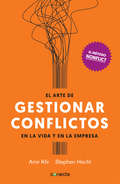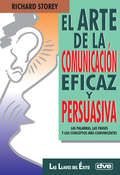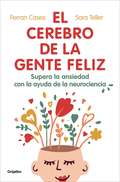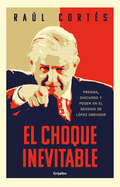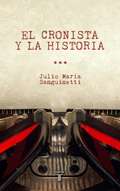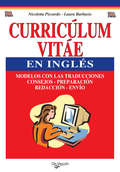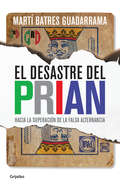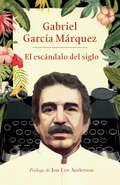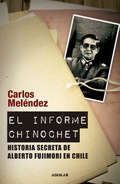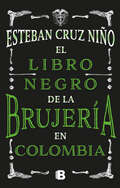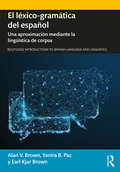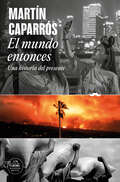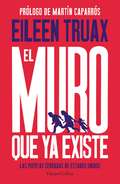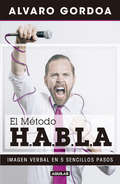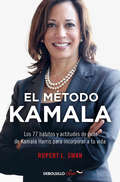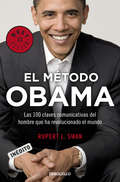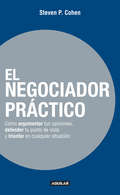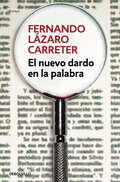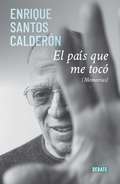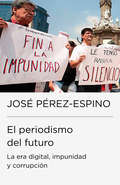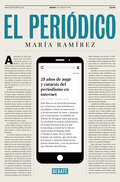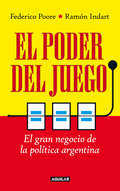- Table View
- List View
El arte de gestionar conflictos en la vida y la empresa: El método Nonflict
by Amir Kfir Stephen HechtEl método Nonflict, adoptado con éxito por empresas y foros de todo el mundo, es un excelente instrumento para la resolución de conflictos en el ámbito laboral, familiar y personal, y permite aprovechar también las oportunidades de crecimiento y de mejora ocultas tras esas desavenencias. ¿Cuál es la mejor manera de afrontar los desacuerdos que surgen a diario en nuestro entorno? Como afirman los autores, los conflictos son en realidad «oportunidades ocultas», y el método Nonflict permite examinar el conflicto subyacente desde los dos puntos de vista y resolverlo positivamente. Concebido como un manual eminentemente práctico y con abundantes ejemplos reales, este libro permite abordar por igual conflictos individuales o de grupo en los ámbitos más diversos, desde el de la pareja o la familia hasta el del mundo laboral. Y, gracias a su probada eficacia, el método Nonflict ha sido adoptado por empresas como Aguas Danone en España, el Grupo Salinas en México o Sakal Media Group en la India entre otras, que lo aplican en el seno de sus organizaciones y en proyectos de gran impacto social. Opiniones:«En Aguas Danone creemos en la diversidad de la fuerza de trabajo y, como en cualquier entorno de trabajo dinámico y heterogéneo, a veces surgen conflictos. Adoptamos el método Nonflict para formar a nuestros directivos con el objetivo de transformar la diversidad en un activo, y su eficacia nos ha llevado a compartirlo con el resto de la organización.»Christian Stammkoetter, director general de Aguas Danone España «El método Nonflict me fue de gran ayuda en una decisiva reunión sindical con mis empleados. Y también me permitió resolver felizmente un explosivo conflicto entre mi esposa y nuestra hija adolescente.»Jason Rosset, presidente de Accuworx «Mis alumnos han utilizado el método Nonflict para resolver conflictos muy complejos y han compartido este valioso instrumento en su entorno personal.»Jim Torczyner, profesor de trabajo social, McGill University
El arte de la comunicación eficaz y persuasiva
by Richard StoreyMuchas personas pasan parte de su tiempo comunicándose de numerosas formas con personas de diferente profesión y nivel cultural (jefes, colaboradores o clientes). En ocasiones deben plantear sus ideas y proyectos para su aceptación y puesta en práctica. Por ello, la capacidad más importante es la persuasión. Todos sabemos lo difícil que es convencer a alguien, pero existen técnicas y procedimientos que dan resultados. Una guía completa con ejemplos, ejercicios y tablas dedicados a temas como la preparación de un informe, su presentación en público, la manera de abordar una cuestión o cómo mantener una entrevista por teléfono. Un auténtico manual, completo y ameno, con el que aprenderá paso a paso todas las técnicas y les dará un toque personal.
El cerebro de la gente feliz: Supera la ansiedad con ayuda de la neurociencia
by Ferran Cases Sara Teller¿Te imaginas cómo sería tu vida sin ansiedad? Este libro es una poderosa herramienta para que la dejes atrás. Si estás atrapado por ella y te aventuras a navegar entre estas páginas, descubrirás por qué te sientes así y cómo, usando técnicas sencillas, tanto físicas como mentales, lograrás superarla. A través de anécdotas muy personales, Ferran Cases cuenta su experiencia con la ansiedad y cómo consiguió vencerla después de más de quince años de sufrimiento. Sara Téller, física y doctora en neurociencia, explica qué pasaba en la cabeza de Ferran cada vez que tenía una crisis y te invita a conocer los secretos del cerebro para que logres olvidarte de la ansiedad para siempre. Este práctico manual te muestra las cosas tal como son, o como la ciencia dice hasta el momento que son, y te invita a ir más allá, ya que entender cómo funciona el cerebro te daun superpoder: comprender cómo funcionas tú, y este es el primer gran paso para vencer la ansiedad. Quizás algo tan sencillo como leer este libro, y aplicar lo que te propone, te permita superar eso que te está minando desde dentro, eso que no te deja disfrutar.
El choque inevitable: Prensa, discurso y poder en el sexenio de López Obrador
by Raúl Cortés¿Por qué López Obrador se ha obsesionado con los medios (sobre todo con los "conservadores"), a quienes considera sus más fieros contrincantes? ¿Por qué miente y desinforma con tanta confianza incluso cuando se le presentan evidencias que anulan sus afirmaciones? ¿Qué consecuencias políticas tiene su actitud retadora y desdeñosa hacia la verdad y los hechos? Sea como un recurso para polarizar al país en su beneficio o como una genuina estrategia de cambio, el presidente de México ha logrado convertir la relación entre el poder y los medios de comunicación en uno de los aspectos centrales de su gestión. Esto ha generado confrontación, pero también dependencia, y ha marcado el ritmo de la discusión pública en México desde que el presidente estableció las conferencias "mañaneras" como la principal vía de comunicación de su gobierno. Este libro registra y analiza esa interdependencia. Mitad crónica de los primeros cuatro años de gobierno de AMLO, centrada en los bulos que se han lanzado día tras día desde el púlpito del presidente, y mitad ensayo sobre el uso político de las fake news y el papel de la ética periodística en un mundo dominado por la desinformación y la infodemia, es uno de los textos que mejor documentan un fenómeno tan complejo como preocupante: las implicaciones políticas de la posverdad.
El cronista y la historia
by Julio María SanguinettiEste libro compila la trayectoria de Julio María Sanguinetti en su rol de periodista, durante más de sesenta años de trabajo. ¿Cómo se veía Cuba en 1959 cuando Fidel asumía personalmente el gobierno? ¿Y Checoslovaquia al borde de la invasión de 1968? ¿Y la Corea del Norte de Kim Il Sung, hoy considerado divinidad por su nieto?Julio María Sanguinetti, en su rol de periodista, estuvo en esos lugares, en aquel tiempo lejano, y escribió crónicas que hoy son historia. También lo son las que publicó en el momento mismo del golpe de Estado uruguayo, en 1973, que no vieron nunca la luz en Uruguay y que fueran publicadas en Argentina, México y también Brasil, donde sufrió la proscripción para escribir de asuntos políticos, tal como le ocurriría luego en nuestro país.En sesenta años de periodismo no ha cesado de mantener su mirada histórica, a través de artículos generalmente # de combate #, referidos al abuso de la memoria, la politización de la historia, la leyenda del # Estado tapón #, la denigración de Rivera, los equívocos en nuestra celebración de la independencia, la laicidad republicana y otros temas que no son pasado congelado sino historia viva.Como dice Marc Bloch, fundador de la historiografía moderna, # la incomprensión del presente nace fatalmente de la ignorancia del pasado #.
El curriculum vítae en inglés
by Laura Barbasio Nicoletta PiccardoSi nos paramos a analizar la cantidad de cartas y correos electrónicos profesionales que hay que hacer hoy en día en inglés o recapacitamos sobre el número de veces en que hemos rectificado nuestro currículum y nos imaginamos unas lecciones ideadas para que se puedan estudiar en 30 minutos, veremos que aprender o perfeccionar el inglés es perfectamente posible y está al alcance de todos. Este libro le enseñará a redactar correctamente cartas comerciales, correos electrónicos y un currículum que le abrirán las puertas al éxito. Incluye vocabulario y expresiones técnicas referentes al mundo laboral, y relativas a distintas áreas (cargos y profesiones, servicios, habilidades y aptitudes, términos comerciales ), un vocabulario imprescindible a la hora de redactar cualquier tipo de escrito en el entorno laboral. Se facilita también un anexo con ejemplos de currículum, cartas y e-mails completos para una mejor comprensión de lo aprendido. Si dispone de 30 minutos al día (de camino al trabajo, en la sobremesa ) no deje de aprovecharlos para ponerse al día con un idioma que le abrirá muchas puertas.
El desastre del PRIAN
by Martí BatresEn este libro, Martí Batres -político y académico de larga trayectoria, actualmente dirigente de Morena- designa como PRIAN a la unión no declarada de dos partidos políticos, PRI y PAN, obstinados en presentarse ante el electorado como antagónicos. Con hondura crítica y datos concretos expone claramente cómo los proyectos de ambos son idénticos y no tienen más finalidad que propugnar y concretar las reformas estructurales de índole neoliberal. Sin embargo, apoyado en referencias estadísticas, sostiene que este propósito mancomunado ha hundido al país en el estancamiento y la pobreza. El desastre del PRIAN no se queda en la crítica: desarrolla propuestas concretas como la disminución del salario de la clase política; el impulso no a la gran empresa sino a la mediana, pequeña y micro; lucha contra la corrupción, recuperación salarial, diversificación de las exportaciones, práctica de una democracia participativa; así como otras medidas políticas, sociales y económicas. Sólo de esta forma, concluye el autor, podrá abandonarse el modelo del PRIAN y cambiar el rumbo de la nación.
El efecto
by Sonia GonzálezAún cuando permanezcan callados, herméticos, tímidos e inexpresivos, todos los individuos transmiten "algo", desde su esencia particular y única.Incluso dormidos, quietos, distantes o de espaldas, siempre infunden parte de sus vidas en las otras personas a su alrededor. Tan solo con el milagro permanente de respirar, proyectan una imagen. Un clima interior que trasciende y revela el "aire" personal. Nadie sabe cómo llamarlo, pero es evidente que ¡ahí está!Ese "soplo" vivencial y personal, no se oye, ni se ve, ni se siente, pero usted lo exhala desde su interior sobre las personas, lo infunde en el ambiente y hasta parece que lo deja impregnado en su en torno. Es su maravillosa huella. Su marca personal.Eso es El efecto. Nadie sabe dónde le queda, pero ahí está siempre. Es su diferencial indescriptible, intangible y fantástico, que lo conecta de manera exclusiva con los demás y lo hace único e irrepetible.Y es justo ese "no sé qué" intangible, pero tan real, lo que lo llevará por las páginas de este fascinante libro de El efecto, que querrá devorar en un día, para saber cuál ha sido su EFECTO de toda una vida.
El escándalo del siglo
by Gabriel García MárquezDejó muy claro Gabriel García Márquez que el periodismo siempre fue su principal pasión, la más perdurable y por la que quiso ser recordado: “No quiero que se me recuerde por Cien años de soledad, ni por el premio Nobel, sino por el periódico. [...] Nací periodista y hoy me siento más reportero que nunca. Lo llevo en la sangre, me tira”. Esta antología pretende ser la muestra más representativa de la tensión narrativa entre periodismo y literatura que recorrió toda su trayectoria como reportero. Cubriendo cuatro décadas, este delicioso viaje a través de medio centenar de textos muestra como “el mejor oficio del mundo” está en el corazón de la obra del premio Nobel colombiano. Con edición a cargo de Cristóbal Pera y prólogo de Jon Lee Anderson, este volumen contiene piezas tan indispensables como los reportajes escritos desde Roma sobre la muerte de una joven italiana, suceso que permitió al autor pintar un fresco incomparable de las élites políticas y artísticas del país en un marco de novela policiaca, crónicas sobre la vida tras el “telón de acero”, sobre la trata de blancas desde París hasta América Latina o apuntes sobre Fidel Castro o Pío XII. Encontramos también fragmentos tempranos en los que aparecen por primera vez las familias Buendía y Aracataca, junto con artículos que contemplan la política, la sociedad y la cultura bajo la luz sólida, profunda y experimentada de ese gran contador de historias que siempre será maestro de periodistas.
El estilo del periodista
by Álex Grijelmo<P>Consejos lingüísticos, profesionales y éticos para escribir en los medios. Un manual lleno de respuestas que puede salir al paso de cualquier duda. <P>La transformación del periodismo provocada por los avances digitales, con nuevas necesidades de información y ritmos más acelerados en la difusión de las noticias, no debiera afectar a la corrección lingüística y el estilo de los textos escritos, y tampoco a la ética de los profesionales. <P>En este contexto, se hace más necesario que nunca un libro que reúna los consejos fundamentales para escribir correctamente en los medios de comunicación. <P>Desde su primera edición en 1997, El estilo del periodista se ha convertido en una obra de referencia fundamental tanto en las facultades de Periodismo de España y Latinoamérica como para los profesionales de la información, los traductores, los profesores de lengua y todos aquellos que se sienten interesados por el lenguaje y el uso que de él hacemos. <P>Esta nueva edición revisada y actualizada por su autor, Álex Grijelmo, constituye una guía de primera mano para moverse entre noticias, crónicas o reportajes, pues está escrita con la perspectiva del periodista que ha vivido los problemas que su profesión plantea en el trabajo diario. <P>Cada capítulo incluye multitud de ejemplos procedentes de periódicos españoles y latinoamericanos, así como numerosas anécdotas sobre las cuestiones tratadas.
El informe Chinochet: Historia secreta de Alberto Fujimori en Chile
by Carlos Meléndez"¿Cómo explicar esta decisión aparentemente irracional de Alberto Fujimori de abandonar la cómoda protección japonesa para asumir las consecuencias de un escenario incierto?". Luego de una investigación paciente y rigurosa, el politólogo Carlos Meléndez logró develar uno de los misterios de la política peruana reciente: ¿por qué Fujimori dejó Japón, donde gozaba de cierta comodidad y considerable protección legal, para partir a Chile, de dónde finalmente sería extraditado? A través de fuentes, documentos enéditos y entrevistas personales con implicados directos, Meléndez logra narrar los entresijos de una estrategia que, hasta hoy, sigue teniendo consecuencias en la vida política peruana, y que marcó no solo el detino del fujimorismo como familia, sino también como partido político. Reseñas "Una lectura obligada para todos los interesados en derechos humanos, política bilateral y política pura, este texto es además informativo, entretenido e iluminador". Patricio Navia "Más que comprender la forma en que Pinochet y Fujimori rompieron el cauce democrático e instititucional en sus países y debieron enfrentar el juicio crítico de sus sociedades por sus abusos y delitos, Meléndez nos invita a imaginar lo que sería ese grifo mitológico llamado "Chinochet" y sobre todo sus crías del siglo XXI. Lea este libro como una novela y quizás su disfrute le haga sentirse menos culpable. Y darse cuenta de que también en los intersticios de la historia el Perú y Chile comparten una tragedia que va más allá de la guerra". Alejandro Neyra
El libro negro de la brujería en Colombia
by Esteban Cruz NiñoIncluye historias sobre la brujería en el Palacio de Nariño durante la presidencia de Ernesto Samper, las maldiciones que rodean al castillo Marroquín y los oscuros rituales que se celebran en la tumba de Pablo Escobar, entre otras. Colombia es una nación en la que la magia parece fundirse con la realidad; un país en donde el realismo mágico surge en cada rincón, y en el que la brujería y los encantamientos se mantienen vigentes a través del tiempo y el espacio. En este nuevo libro, Esteban Cruz Niño reúne diez casos relacionados con estos temas en Colombia, en donde mezcla una rigurosa investigación periodística -de fuentes actuales e históricas- con entrevistas a personajes famosos y de la cultura popular del país para demostrar cómo la brujería, desde siempre, ha permeado todas las esferas de la sociedad.
El léxico-gramática del español: Una aproximación mediante la lingüística de corpus
by Alan V. Brown Yanira B. Paz Earl Kjar BrownEl léxico-gramática del español ofrece una aproximación alternativa al estudio de la gramática avanzada del español. Este libro brinda al estudiante un enfoque auténtico y contextualizado del uso del español, basándose en datos provenientes de corpus de español-L1 y L2 junto a la investigación lingüística a fin de describir las características léxico-gramaticales fundamentales de la lengua y su variación. Cada capítulo incluye actividades guiadas para que los estudiantes puedan realizar búsquedas en estos corpus con el propósito de llegar a conclusiones fundamentadas en evidencias empíricas sobre cómo los aprendices de varios niveles de competencia usan ciertos elementos léxico-gramaticales. Este libro representa un recurso ideal para los estudiantes de la gramática avanzada del español a nivel de pregrado y posgrado. El léxico-gramática del español provides an alternative approach to the study of advanced Spanish grammar. Drawing on L1 and L2 Spanish language corpora and linguistic research to describe key lexico-grammatical characteristics of the Spanish language, this book gives students insight into real, variable, and contextualized usage of Spanish. Each chapter includes guided exercises so that students can conduct their own searches of the corpus and draw evidence-based conclusions on how particular grammar structures are used by Spanish speakers at varying levels of proficiency. This is an ideal resource for advanced undergraduate and postgraduate students of Spanish language and linguistics.
El mundo entonces
by Martín Caparrós*Premio Ortega y Gasset de Periodismo a la trayectoria profesional 2023* El mundo entonces es un fascinante retrato de nuestro presente, una herramienta que sirve para definir qué hacemos, quiénes somos, quiénes –quizá– seremos. «Martín Caparrós, uno de los más geniales cronistas contemporáneos, depura de manera exquisita, emocionada, vibrante y distanciada una prosa de un poderío narrativo excepcional». Fernando R. Lafuente, ABC Cultural El mundo entonces es una guía para entender el mundo en que vivimos. Escrito –propone Caparrós– por una historiadora del siglo XXII, resume y entrecruza los principales hilos conductores de nuestra organización social, económica, política y cultural para ofrecernos un panorama general de nuestra sociedad en el fin de la Era del Fuego. Sus capítulos incluyen desde la explosión demográfica hasta los cambios en el amor, la familia y la situación de las mujeres, pasando por las nuevas formas del trabajo, la irrupción de la IA, el poder de las grandes corporaciones digitales y su peso en nuestras vidas, el avance chino y el descrédito de las democracias, los cambios en el ocio y la alimentación, las nuevas formas de hacer la guerra y las viejas formas de creer en dioses. Todo contado de una forma sencilla y amena, enriquecida por análisis y datos que iluminan nuestra realidad con nuevos sentidos, miradas diferentes.Una primera aproximación a este proyecto fue publicada a lo largo de varios meses en El País. Este libro es su versión actualizada y aumentada con los perfiles de 25 personajes que definen nuestra época, desde Putin o Messi o Elisabeth Holmes hasta una pastora mongola o un príncipe de las islas Marshall o una obrera bengalí. Sobre el autor y su obra se ha dicho:«Un exquisito de la escritura y un lector omnívoro [...] Caparrós es una manera de ver y de entender el mundo».Carles Geli, Babelia «Caparrós es un maestro de la crónica».Juan Villoro, Reforma «Su prosa y su mirada son un reactivo fuerte para almas sensibles o amigas de lo políticamente correcto».Leila Guerriero, El País«El mejor cronista actual de América Latina: un soberbio entrevistador, un viajero dotado de cultura enciclopédica y de una fina ironía».Roberto Herrscher, La Vanguardia «El autor argentino despliega en Ñamérica el retrato coral de un continente marcadopor los tópicos literarios, el maniqueísmo histórico y la desigualdad económica».Andrea Aguilar, Babelia, El País «El conjunto es el resultado deun esfuerzo superheroico por contar y pensar de nuevo —y con nuevas ideas— medio continente».Jorge Carrión, La Vanguardia (sobre Ñamérica)
El muro que ya existe
by Eileen TruaxDurante décadas ha operado una máquina anti inmigratoria del gobierno estadounidense en connivencia con el mexicano, cometiendo violaciones a los derechos humanos e incumpliendo los estatutos internacionales para brindar refugio. En un país que empezó teniendo perseguidos políticos desde el salinismo, hasta el masivo desplazamiento forzada a causa de las políticas de seguridad del calderonismo, Eileen Truax, expone a través de un reporteo altamente contextualizado, las historias de quienes huyen de manera desesperada y sin encontrar el cobijo legal, económico y social de su país de origen, ni en el que históricamente se ha comprometido ante el mundo.
El método H.A.B.L.A: Imagen verbal en 5 sencillos pasos
by Álvaro GordoaAprende a comunicarte con los demás de manera asertiva y alcanza el éxito en tu vida. El Método H.A.B.L.A. te permitirá capacitarte directamente con el principal maestro y especialista en el tema de la Imagen Verbal ®. Hablar lo hace cualquiera. Penetrar en la mente del otro, necesita de un método. En este libro encontrarás un sencillo y divertido camino a seguir, con todas las claves para hablar en público y gozar de los beneficios de la comunicación de alto impacto. Con recomendaciones que podrás implementar de inmediato y sorprendentes revelaciones que desmitifican la dificultad de hablar en público. Figuras públicas opinan sobre este libro: "El saber hablar en público es de las habilidades que más admiro y Alvaro ha hecho de esto algo sencillo y divertido. De primera mano les garantizo que este método les cambiará la vida. A partir de hoy simplemente ¡H.A.B.L.A.!" -Martha Debayle, empresaria y comunicadora, reconocida como una de las mujeres más influyentes de Latinoamérica- "Hablar en público no es sólo para los políticos, hoy todos tenemos la necesidad de hacerlo bien y con claridad. Alvaro Gordoa, con El Método H.A.B.L.A., nos enseña cómo." -Fernando Lerdo de Tejada, ex vocero de la Presidencia de la República y experto en cabildeo y comunicación- "De El Método H.A.B.L.A. aprendí muchas cosas que uso diariamente en mi vida profesional. Alvaro te enseña a disfrutarlo tanto, que hablar en público pasa de ser una preocupación a una adicción." -Yordi Rosado, conductor, productor, conferencista y autor bestseller- "Con El Método H.A.B.L.A. los lectores entenderán muy fácilmente los principios de la oratoria y podrán enfrentar a un público y expresar sus ideas con claridad. Es un método que recomiendo ampliamente." -Antonio Asali, V.P. de Comunicación Verbal de la Asociación Mexicana de Consultores Políticos-
El método H.A.B.L.A: Imagen verbal en 5 sencillos pasos
by Álvaro GordoaAprende a comunicarte con los demás de manera asertiva y alcanza el éxito en tu vida. El Método H.A.B.L.A. te permitirá capacitarte directamente con el principal maestro y especialista en el tema de la Imagen Verbal ®. Hablar lo hace cualquiera. Penetrar en la mente del otro, necesita de un método. En este libro encontrarás un sencillo y divertido camino a seguir, con todas las claves para hablar en público y gozar de los beneficios de la comunicación de alto impacto. Con recomendaciones que podrás implementar de inmediato y sorprendentes revelaciones que desmitifican la dificultad de hablar en público. Figuras públicas opinan sobre este libro: "El saber hablar en público es de las habilidades que más admiro y Alvaro ha hecho de esto algo sencillo y divertido. De primera mano les garantizo que este método les cambiará la vida. A partir de hoy simplemente ¡H.A.B.L.A.!" -Martha Debayle, empresaria y comunicadora, reconocida como una de las mujeres más influyentes de Latinoamérica- "Hablar en público no es sólo para los políticos, hoy todos tenemos la necesidad de hacerlo bien y con claridad. Alvaro Gordoa, con El Método H.A.B.L.A., nos enseña cómo." -Fernando Lerdo de Tejada, ex vocero de la Presidencia de la República y experto en cabildeo y comunicación- "De El Método H.A.B.L.A. aprendí muchas cosas que uso diariamente en mi vida profesional. Alvaro te enseña a disfrutarlo tanto, que hablar en público pasa de ser una preocupación a una adicción." -Yordi Rosado, conductor, productor, conferencista y autor bestseller- "Con El Método H.A.B.L.A. los lectores entenderán muy fácilmente los principios de la oratoria y podrán enfrentar a un público y expresar sus ideas con claridad. Es un método que recomiendo ampliamente." -Antonio Asali, V.P. de Comunicación Verbal de la Asociación Mexicana de Consultores Políticos-
El método Kamala
by Rupert L. SwamAprende los hábitos diarios de Kamala Harris para lograr tus metas. Kamala Harris ha hecho historia. No solo se ha convertido en la primera mujer en ocupar el cargo de vicepresidenta de Estados Unidos, sino que es también la primera persona afroamericana en este puesto. Sin embargo, su camino no ha sido fácil y tampoco parece que vaya a acabar aquí. El método Kamala nos presenta los cien aspectos decisivos en la vida de Harris: sus hábitos, sus puntos de inflexión, su modo de enfrentarse a los conflictos... Los detalles del día a día son lo que construyen el destino de cada uno, y este libro nos acerca a los de una mujer hecha a sí misma para poder aplicarlos a nuestra vida.
El método Obama: Las 100 claves comunicativas del hombre que ha revolucionado el mundo
by Rupert L. SwamAplica en tu vida cotidiana las estrategias de éxito de Barack Obama. La campaña que llevó a Barack Obama, un afroamericano hijo de inmigrante, a ocupar la presidencia de Estados Unidos estuvo marcada por una capacidad de comunicación extraordinaria que rompió esquemas. El método Obama es un manual práctico que recoge en cien capítulos breves la forma en que el «Kennedy del siglo XXI» transmitió sus mensajes: desde la importancia de la retórica, el cuidado de la imagen y el dominio del protocolo (incluso para saltárselo), hasta cómo reafirmar la identidad, liderar grupos humanos y, principalmente, desarrollar el carisma personal. Con todo ello construiremos una estrategia comunicativa eficaz para alcanzar el éxito en la vida personal y profesional, y en situaciones cotidianas tan concretas como una entrevista de trabajo, una presentación en público o una primera cita sentimental.
El negociador práctico: Cómo argumentar tus opiniones, defender tu punto de vista y triunfar en cualquie
by Steven P. CohenEl negociador práctico brinda respuesta a una amplia gama de problemas de negociación que enfrentan las personas en diferentes países alrededor del mundo. De Stephen P. Cohen, exitoso consultor en el sector privado. Aprende cómo encontrar a tu negociador interior. <P><P>Conviértete en un experto de la negociación y aumenta tu confianza, destaca tus fortalezas y desarrolla estrategias. Ponerse de acuerdo con los demás puede ser muy complicado, sin embargo, es algo necesario en la vida diaria. El negociador práctico desmitifica lo complejo de la negociación, ofreciendo técnicas de acercamiento que cualquier persona puede utilizar, sin importar en qué situación se encuentre. <P><P>El negociador práctico ofrece respuesta a varias preguntas realizadas por alguien en busca de consejo. El enfoque del libro te ayudará a: evaluar tus intereses y fortalezas y encontrar maneras de construir sobre ellos; comprender la situación y sus posibilidades; aumentar tu confianza en el trato con los demás; desarrollar y aplicar estrategias sencillas y prácticas para incrementar tus intereses.
El nuevo dardo en la palabra
by Fernando Lázaro CarreterLa acogida excepcional que, hace cinco años, obtuvo la compilación de los artículos aparecidos con el título El dardoen la palabra ha llevado a Fernando Lázaro Carreter a reunir en este volumen los publicados desde 1999 en el diario El País.Con erudición y agudo sentido del humor, el eminente académico alerta acerca del desconocimiento de los recursos del propio idioma, tan recuente en cuantos gozan de vida pública, y el aluvión acrítico de términos nuevos innecesarios, que hacen peligrar la comunicación entre millones de hispanohablantes. Procurar la estabilidad del español es una labor que corresponde a todos los hablantes con una conciencia crítica. A ellos van destinados estos «dardos». Reseña:«Los dardos no están hechos para multar ni para encarcelar a nadie, soloquierenser unallamadade atención para no desviarse del camino que la comunidad lingüística nos traza. Una excelente llamada.»El Cultural
El país que me tocó (Memorias)
by Enrique Santos CalderónMemorias de Enrique Santos Calderón uno de los referentes periodísticos en Colombia. Desde muy joven demostró una voluntad de independencia que, en los años sesenta, tomó vuelo con el ideario marxista, el rock y el hippismo. Primogénito de una de las familias más influyentes en la historia del país, Santos cuestionó el establecimiento desde adentro. Con su legendaria revista Alternativa marcó a toda una generación y con su columna "Contraescape" fue la voz más leída en uno de los momentos críticos de la política colombiana A sus setenta años, Enrique Santos evoca en sus memorias a quienes formaron su sensibilidad y pensamiento, los eventos que encauzaron su evolución política y periodística; recuerda a su familia, amigos y enemigos, y con su vida de fondo reflexiona sobre la Colombia de las últimas cinco décadas. Un libro rico en anécdotas y grandes personajes que registra el proceso vital de alguien que defendió la libertad en todas sus formas y que fue testigo privilegiado del país a veces fascinante, a veces frenético y violento, de la segunda mitad del siglo XX y el tránsito al XXI.
El periodismo del futuro: La era digital, impunidad y corrupcción
by José Pérez-Espino"La afirmación de que las redes sociales representan una amenaza para el periodismo se convirtió en un axioma mediático. Es una frase muy llamativa, pero falsa." José Pérez-Espino Los nuevos formatos de presentación y consumo de contenidos informativos han obligado a los periodistas a buscar una reinvención permanente. En cualquier caso, asegura José Pérez-Espino, sobrevivirán los medios que apuesten por la investigación para dar sentido a la pluralidad, siempre que usen las herramientas digitales disponibles bajo principios éticos y de compromiso con sus lectores. Sin embargo, la tecnología y las redes sociales no representan una amenaza real para el periodismo: las verdaderas amenazas son la impunidad y la indolencia en las agresiones y los asesinatos de comunicadores. En tal contexto, asegura José Pérez-Espino, resulta fundamental exigir a las autoridades investigaciones puntuales para aclarar los crímenes y hacer justicia. Sin duda, estamos ante un reportaje contundente y de gran actualidad que aborda los elementos necesarios para emprender una urgente reflexión acerca del futuro de ese oficio de alto riesgo llamado periodismo.
El periódico: 25 años de auge y catarsis del periodismo en Internet
by María RamírezLa historia de España a través de su prensa. Un ensayo nostálgico y sin embargo optimista. ¿Por qué este libro?Los últimos veinticinco años han sido tal vez los más agitados para la historia de los periódicos en lo que se refiere a la revolución de las herramientas y el impacto global de lo que hacemos. En un momento como este, de ebullición de la información y también de confusión sobre qué es el periodismo, tenía especial interés en mirar atrás y contar, a través de mi experiencia personal, la vida de redacciones entre ilusiones, desilusiones y la energía infinita que siempre nos dan las noticias. Defina la situación de la prensa en una frase.La prensa siempre está en busca de un camino y lo encuentra más a menudo de lo que parece. ¿Puede sobrevivir el periódico en la era de internet?El periódico ha cambiado y se enfrenta continuamente a nuevos dilemas. Cada vez está más claro que su modelo de negocio solo es verdaderamente lucrativo para unos pocos medios en el mundo. Pero no solo ha sobrevivido a internet, sino que en muchos casos ha florecido en su era. La prueba de ello es la cobertura de las turbulencias de los últimos años, desde la victoria de Donald Trump y el Brexit hasta la pandemia y la invasión rusa de Ucrania. ¿Qué nos enseña la revolución digital en Estados Unidos?La lección es que la grandeza de los periódicos está en sus redacciones, su misión y su trabajo más básico que cosecha éxitos cuando los recursos y las prioridades están en el corazón de la información. Les costó, pero al final los triunfadores de la nueva era del periodismo en internet han sido el New York Times, el Washington Post o incluso el Boston Globe, y no tanto Buzzfeed, Vox Media y otras startups que supuestamente iban a reinventar el modelo de negocio porque los periodistas no éramos capaces de hacerlo. ¿La prensa española ha estado a la altura de la revolución de internet?Como sugieren varias personas entrevistadas en este libro, a menudo los gestores de las empresas llegaron tarde, gastaron demasiado donde no debían o confiaron en falsos gurús, pero esto ha contrastado a menudo con el empuje y la capacidad de reinvención de los periodistas. No es casualidad que España sea uno de los pocos países europeos donde hay un número significativo de medios influyentes y rentables que han nacido en internet.
El poder del juego
by Ramón Indart Federico PooreUn libro indispensable para conocer la trama oculta que se pone en marcha cada vez que alguien se sienta ante una máquina tragamonedas, apuesta fichas en un paño verde o llena una tarjeta de bingo. Los juegos de azar en la Argentina conforman un negocio fabuloso que usufructúan empresarios vinculados al poder y que logra sobrevivir a los cambios de gobierno. A partir de la incorporación de las máquinas tragamonedas, las apuestas on line y las ruletas electrónicas, no solo se multiplican las ganancias sino también los jugadores, y la proliferación de bingos y casinos urde una telaraña que atrapa a cada vez más argentinos. Los periodistas Ramón Indart y Federico Poore siguen el hilo de la connivencia de la clase política -desde Eduardo Duhalde y Néstor Kirchner hasta Mauricio Macri y Hermes Binner- con los operadores del juego en la Argentina. El resultado de ese trabajo minucioso, exhaustivo y sin concesiones revela un mundo en el que abundan las influencias, los intercambios de favores y una circulación poco clara de poderes y de dinero.
